
Contact address: Laura.zumbrink@agri-at.com
Laura Zumbrink studied Agricultural Sciences with special emphasis on poultry at the University of Applied Sciences in Osnabrueck, Germany (bachelor’s degree). For the master’s degree, she studied agricultural sciences with a focus on agribusiness at the University of Goettingen, Germany.
In cooperation with the company Agri Advanced Technologies (AAT), she dedicated her master’s thesis to the topic: “In ovo sex determination using hyperspectral imaging technology – Animal welfare compliant anaesthesia of male embryos and consideration of the economic consequences”.
Abstract
The aim of in ovo sex determination in chicken hatching eggs is to detect male embryos and terminate their development at an early stage of incubation to avoid killing day-old-chicks after hatch.
Since there is no secure scientific knowledge on presence or absence of pain perception between day 7 and 15 of incubation, it is necessary to develop animal welfare friendly and consumer acceptable procedures to end the embryo`s development.
This article presents a recently developed anaesthesia method for chicken embryos in the egg. The stunning ensures that the embryos are in a state of insensibility and insensivity.
The method achieves an efficacy of >99% and has also been successfully tested in high throughput use.
Keywords:
In ovo sex determination; stunning; male chicken embryo; animal welfare; hyperspectral imaging; poultry welfare.
Introduction
All currently market-ready procedures for in ovo sex determination of laying hens are performed in the second third of the incubation period (BOURIN et al., 2020; PREISINGER, 2020; RICHARD, 2020).
Whereas embryos in the first trimester of the incubation period are not yet able to perceive pain, it has been scientifically proven that pain perception exists in the third trimester of incubation. For the second trimester (incubation day 7-14), it is not clear whether pain perception is possible (CHUMAK, 1961; MELLOR and DIESCH, 2007; BJØRNSTAD et al., 2015; Deutscher Bundestag, 2017; BARTELS et al., 2020).
In order to avoid a possible pain at the end of the development of the sorted-out embryos, a stunning procedure should be used to bring them into a state of insensibility.
The EC Regulation No. 1099/2009 generally allows simultaneous stunning and killing by mechanical disruption. However, this is hardly accepted socially and is often perceived as unaesthetic (HIRT, 2004; LEENSTRA et al., 2011).
The electrical stunning of chicken embryos is intended to replace maceration of embryos. This procedure is considered more appropriate for animal welfare and more acceptable to society.
Material and methods. Development of the stunning concept
One currently market-ready method for in ovo sex determination is hyperspectral imaging in layer lines from genotypes with sex-linked plumage colors on the 13th day of the incubation period, as described by GÖHLER et al. (2017).
Possible stunning methods considered include the application of electrical current, CO2 and low atmosphere pressure, use of anaesthetics. Different approaches of electrical stunning of broilers were tested to find an applicable method for stunning of chicken embryos.
Electrical water bath stunning represents a current procedure in chickens, rainbow trouts and carps (PRINZ et al., 2012; REIMERS, 2008; RETTER, 2014). This stunning system was tested with embryos, where one egg at a time was placed between two plate electrodes in a water basin.
In a second approach perfusion was tested with two electrodes applied to the outside of the eggshell on each pole side.
These two methods turned out to be not applicable because the eggshell protects the embryo effectively.
A reliable current flow to the embryo could be achieved when two electrodes were inserted through the eggshell on the pole sides to get in contact with the egg fluid, as shown in Figure 1.
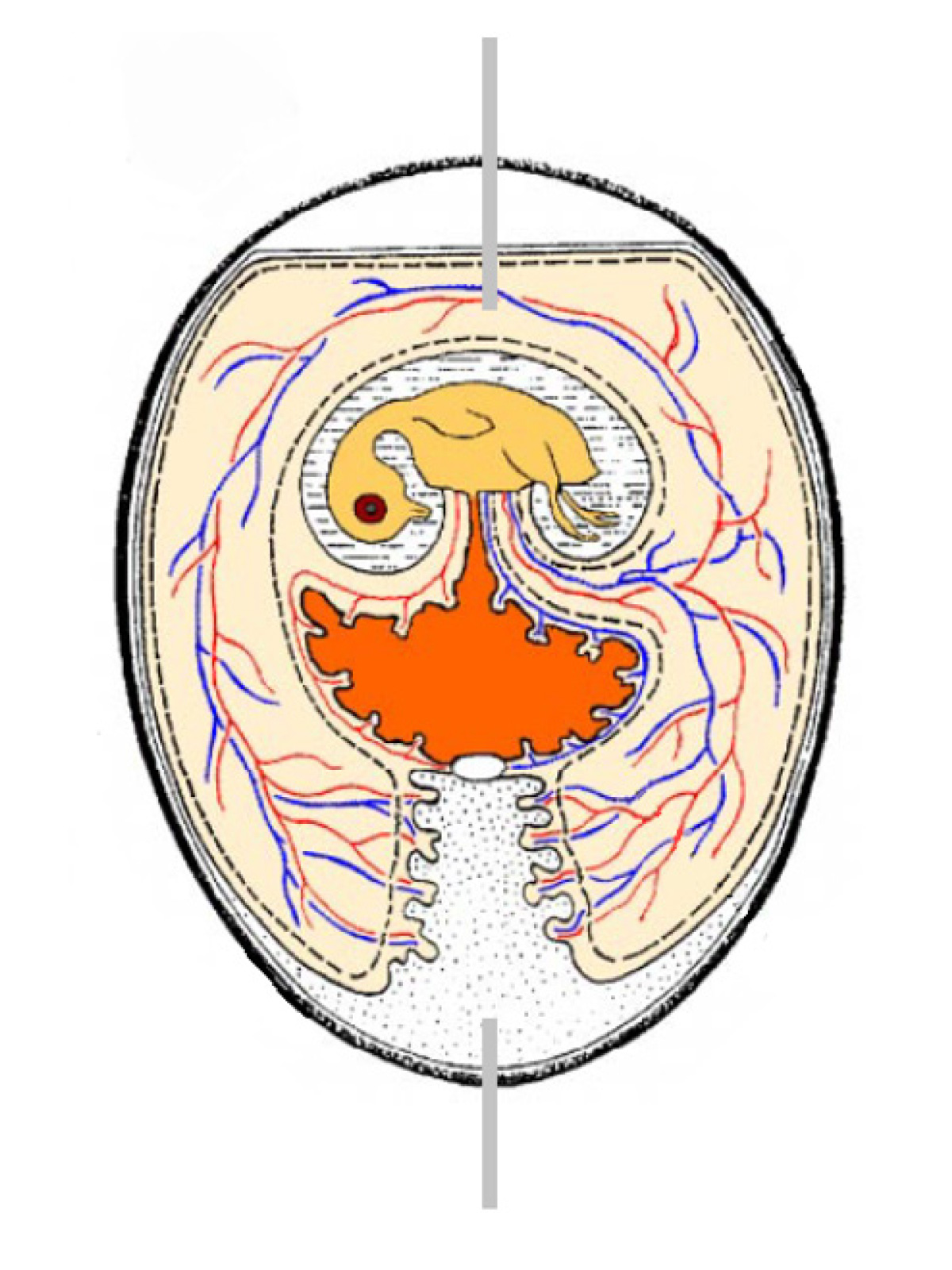
Initial experiments showed the most promising results with a 2-second current flow at 110 V and 50 Hz sinewave. Consequently, a special manually operated test device was developed which allowed the control of the penetration depths of the electrodes at various egg sizes (Figure 2 and Figure 3).
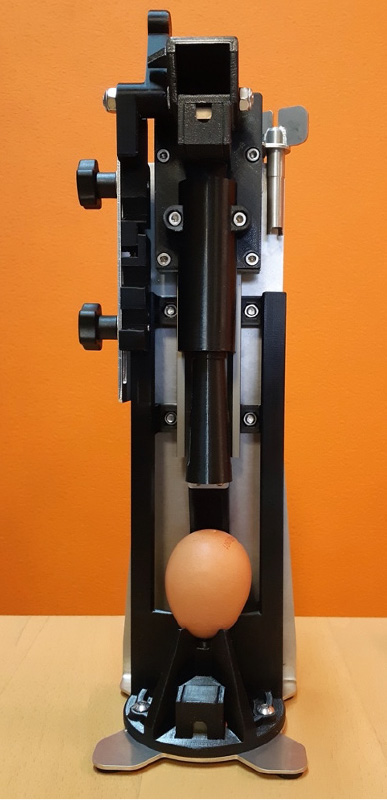
Amperage, temperature of the egg shell and heart rate are measured.
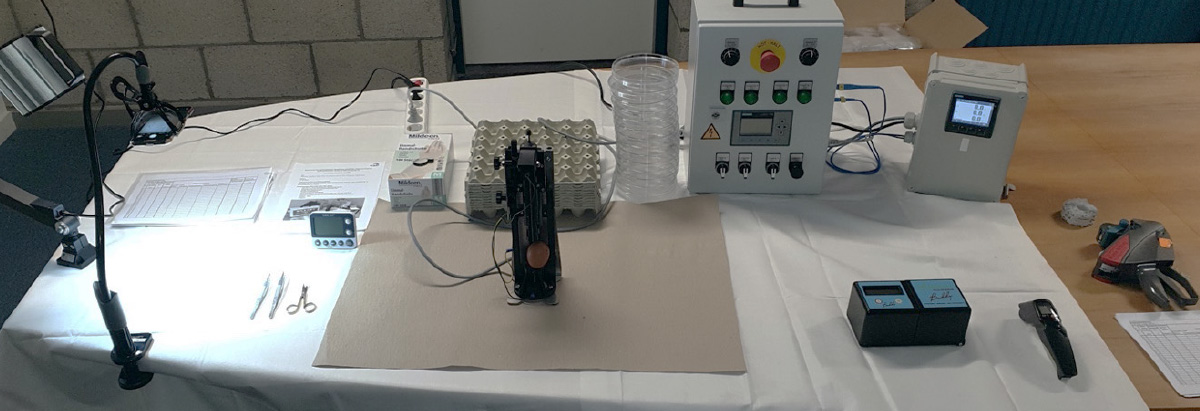
Proof of concept
In two trials the suitability of the stunning concept was examined under laboratory conditions. For both trials LOHMANN Brown hatching eggs (300 and 50 eggs in trial 1 and 2 respectively) on the 13th day of incubation were used.
Each hatching egg was placed into the test stand and the electrodes were inserted through the eggshell at both poles. During the 2-second application the maximum current was recorded.
The heartbeat of the embryos was measured using a digital egg monitor. Eggshell temperature was measured with an infrared thermometer. After the treatment the eggshell was opened and the embryo, including egg liquid and yolk, was placed on a petri dish.
Embryos were visually assessed for at least 60 seconds for the following criteria: beak opening, movement of head, wings, toes/legs and reaction on mechanical irritation with a forceps. 15 non-treated eggs were assessed as control in trial 1.
An embryo was considered successfully anesthetised if it did not show spontaneous movements and reactions to mechanical stimulation (Figure 3, experimental set-up).
In some cases jerky movements were observed for a few seconds after treatment. These movements were recorded but not considered as indicators of consciousness. On the basis of these observations the results were allocated to the following categories: Motionless/anesthetised, Motion/anesthetised, Motion/non-anesthetised, and control.
The second trial series was conducted to investigate whether the electrodes can hit and injure the embryo.
For this purpose, the electrical current flow was applied to windowed eggs in the horizontally oriented test stand.
Before the onset of current flow, parts of the eggshell were removed using forceps to create a large hole in the egg for observation of the embryo. Apart from that, the procedure was just the same as for the first trial (Figure 4).
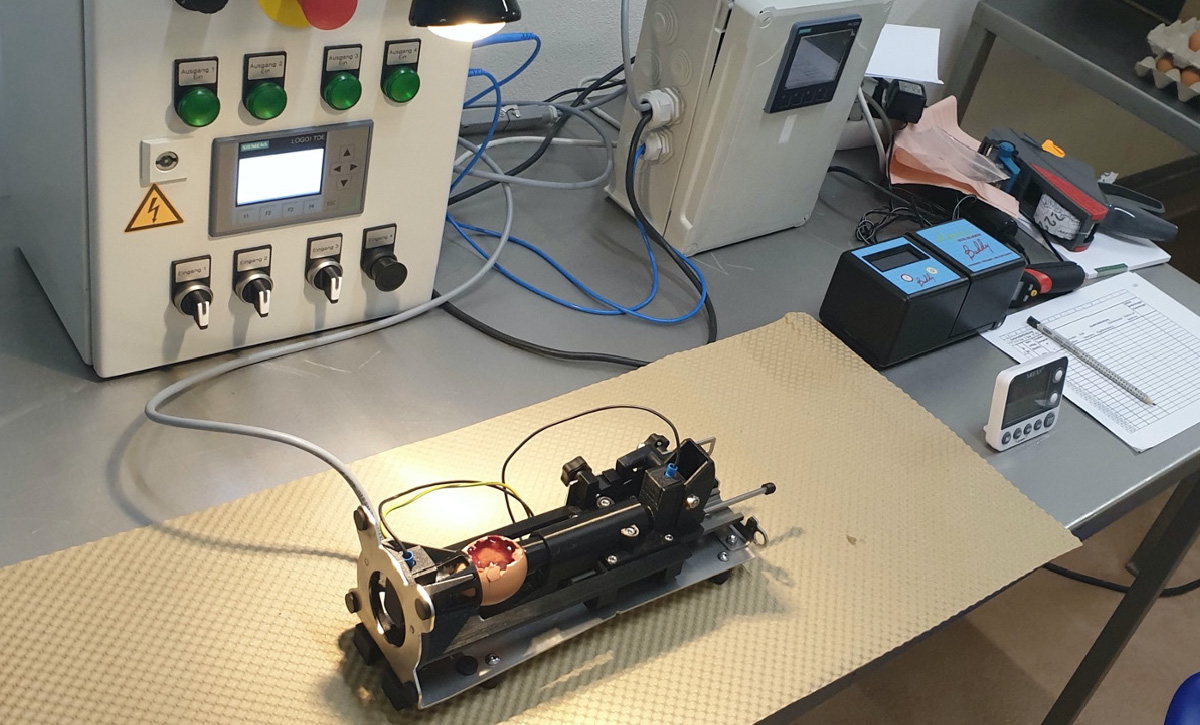
Statistical Analysis
IBM SPSS Statistics 26 was used for the statistical analysis, and descriptive studies were used to determine the location parameters and measures of variation of the variables.
By applying contingency table, chi-square test and measures of association phi and Cramer’s V, it was determined whether the independent variables “heartbeat”, “maximum current” and “egg temperature” each had a significant impact on the dependent variable, the anaesthesia result. Only the groups “motionless/anesthetised” and “motions/anesthetised” were considered, because the group “motions/non-anesthetised” had too few accounts for a statistical analysis (n = 2).
The binary logistic regression examined the association of the three independent variables (heartbeat, current, temperature) with the binary coded dependent variable (anaesthesia result: 0 = movement/anesthetised, 1 = movement/non-anesthetised).
Furthermore, the five criteria were evaluated and compared with each other using the measures of association phi and Cramer’s V. Level of significance was set at p < 0.05.
High-throughput stunning unit
The results of the two trials were used as a basis to develop a fully automated high-throughput system, which is currently already in use in hatcheries (Figure 5). The results of the laboratory tests could be verified in routine use under practical conditions.
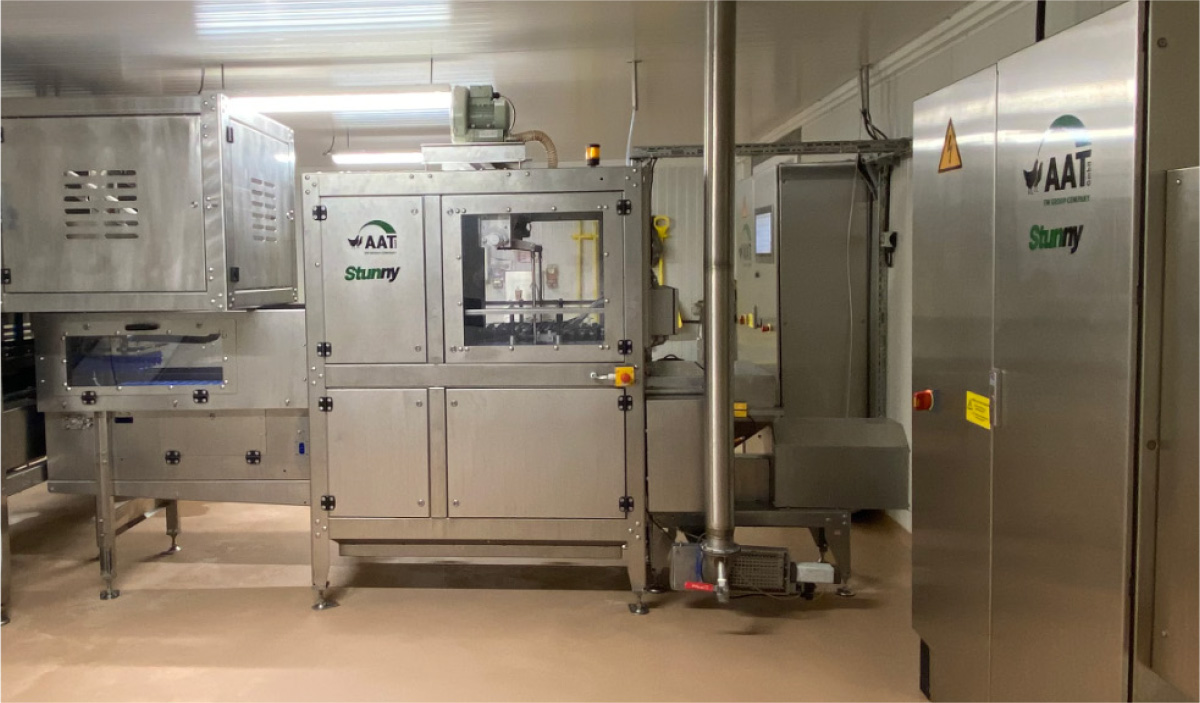
In collaboration with the German Training and Consultancy Institute for animal welfare at transport and slaughter (bsi Schwarzenbek) the high throughput machine has been evaluated based on further clinical examinations of the embryos and analysis of a large number of current flow data.
Samples of eggs (standard eggs and slanted eggs) were taken out of the machine after the treatment to monitor the five criteria at the embryos.
Furthermore, the current measurement of the device was checked with external devices on a large number of treatments by VON WENZLAWOWICZ (2021).
Results
In the first trial average heartbeat of the embryos was 205 beats per minute (BPM) before treatment and mean eggshell temperature was 32.2°C. The average of maximum current measured during electrical flow was 3.82 A (Table 1). 99.3 % of the treated embryos were classified as successfully anesthetised (Table 2).
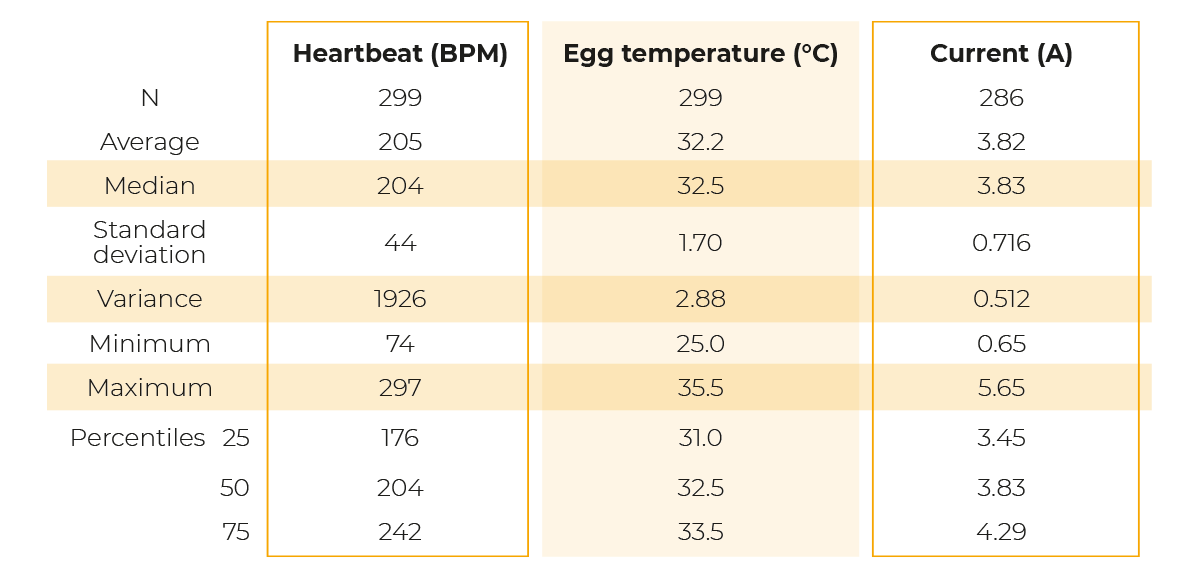

Binary logistic regression yielded a significant model with all three variables (p = .000). However, none of the variables reached a significant coefficient (heartbeat p = .713; egg temperature p = .354; current intensity p = .179), so no probabilities could be derived.
Regarding the analysis of the five evaluation criteria, there was a significant difference (p = .000) between treatment and control group for all criteria.
For head movements, wing movements, legs and toe movements, and response to tactile stimulation, the measures of association phi and Cramer’s V were each V = .959, corresponding to a strong association according to COHEN (1988).
The association for beak opening was slightly weaker at V = .872, but still corresponds to a strong association.
In the second trial, in none of the observed embryos injuries caused by the electrodes were detected. Through the window in the eggshell, it was observed that the embryos showed a short cramping during the current flow, after which they were motionless (ZUMBRINK et al., 2020).
Out of 49 treatments, 48 embryos (97,9 %) were classified as successfully anesthetised due to the absence of movements (Table 3).

After treatment in the high-throughput machine, the clinically examined embryos also were classified as successfully anesthetised due to the absence of movements and reactions, following ZUMBRINK et al. (2020). The current measurements showed differences between the machine’s own measurement and that of the external devices.
Overall, the fully automated stunning unit was evaluated by bsi Schwarzenbek as suitable for reliable stunning of embryos in the egg on the 13th day of incubation.
Discussion
From a practical point of view, maceration for stunning and killing is not only permitted by law (EC Regulation 1099/2009; TierSchlV), and considered a fast, safe, and humane way to terminate the embryonic development without possible pain or suffering (JAKSCH, 1981; BANDOW, 1987, loc. cit. CLOSE et al., 1997; HIRT, 2004; AVMA; 2020). However, maceration is often perceived to be unaesthetic (JAKSCH, 1981; GASSMANN-LANGMOEN and SCHATZMANN, 1990, loc. cit, HIRT, 2004).
For example, respondents in surveys overwhelmingly prefer CO2 treatment over maceration (LEENSTRA et al., 2011), although the latter is criticized from a scientific perspective (SCHATZMANN 1997, loc. Cit. HIRT, 2004; HIRT, 2004; LOURENS and GERRITZEN, 2009). CO2 treatment and cooling have not been used mainly because the procedures take a long time and the time to stun or to death cannot be clearly determined (LOURENS and GERRITZEN, 2009, AVMA, 2020).
The same is the case for Low Atmosphere Pressure Stunning (BATTULA et al., 2008; VIZZIER-THAXTON et al., 2010; SCHILLING et al., 2012; MCKEEGAN et al., 2013), which is furthermore not accepted by EFSA (2014).
The use of anesthetics is expensive, and the remains of the hatching eggs cannot be easily used in feed or pet food (AVMA, 2020). The judicious use of hatching eggs as a high-quality protein source is considered important by probands (LEENSTRA et al., 2011) and makes the process particularly sustainable and resource efficient.
According to EC Regulation 1069/2009 the remnants arising from electrical stunning are classified as category 3 and can therefore be used as a high-quality protein source in petfood and livestock feed.
Reflexes such as the corneal reflex, which can be used in birds to assess unconsciousness in birds (HEATLEY, 2008 according to LIERZ and KORBEL, 2012), are not yet developed in embryos on day 13 of incubation. PRINZ et al. (2012) concluded that reflexes cannot be used to assess the state of anaesthesia in broilers and EEG are the only reliable method. However, EEG cannot be measured in embryos at this age (MELLOR and DIESCH, 2007).
According to CHUMAK (1961) and ALEKSANDROWICZ and HERR (2015), five criteria can be used as a basis for evaluating successful anaesthesia: Absence of beak opening, movement of head, wings, toes or feet and reaction to tactile stimulation.
These five criteria proved to be suitable for the assessment in the present study. The statistical evaluation with phi and Cramers V showed a significant, strong association between treatment and all five criteria. The analyses showed a reliable and repeatable effect of electrical anaesthesia. 99.3% of the embryos were successfully anesthetised.
ZUMBRINK et al. (2020) concluded that the measurement of the amperage as root mean square yields more reliable values than the peak value measurements they used. Therefore, the root mean square measurement was implemented in the high-throughput machine.
A certain current threshold required to induce successful anaesthesia could not be determined in any of the studies. Rather, a good anesthetic effect is achieved as soon as a safe current flow is reached over the two seconds (ZUMBRINK et al., 2020; VON WENZLAWOWICZ, 2021).
The electrical treatment of the embryos in the hatching egg – preceding homogenization – is intended to induce the embryos to be in a state of temporary unconsciousness. They are thus protected from perceiving pain during the process of maceration.
According to the studies of ZUMBRINK et al. (2020) under standardized conditions, the application of 110 volts for 2 seconds can ensure this state.
This has been confirmed by VON WENZLAWOWICZ (2021) who concluded in the survey of the high-throughput system that the fully automated technology implements the stunning concept as required and is thus suitable for stunning chicken embryos in the second third of incubation.
Conclusions
In summary, the electrical stunning described in this paper implements a fast, respectful, and accepted anesthesia of the male embryos. A very promising “proof of concept” has been provided. Based on this concept, a high-throughput machine was successfully developed, whose suitability for stunning chicken embryos in the second third of incubation was confirmed in an expert survey.
References
ALEKSANDROWICZ, E., HERR, I., 2015: Ethical euthanasia and short-term anesthesia of the chick embryo. ALTEX 32(2), 143-147.AMERICAN VETERINARY MEDICAL ASSOCIATION (AVMA), 2020: AVMA Guidelines for the Euthanasia of Animals: 2020 Edition. Version 2020.0.1. Schaumburg, IL.
BANDOW, J.H., 1987: The humane disposal of unwanted day old chicks and hatchery eggs in the poultry industry. Report for the Canadian Federation of Humane Societies, Ontario, Canada.
BARTELS, T., WILK, I., SCHRADER, L., 2020: Entwicklung von Nozizeption und Schmerzempfinden bei Hühnerembryonen. Friedrich-Loeffler-Institut, Greifswald – Insel Riems.
BATTULA, V., SCHILLING, M. W., VIZZIER-THAXTON, Y., BEHRENDS, J. M., WILLIAMS, J. B., SCHMIDT, T. B., 2008: The effects of low-atmosphere stunning and deboning time on broiler breast meat quality. Poultry Science, 87(6), 1202-1210.
BJØRNSTAD, S., AUSTDAL, L. P. E., ROALD, B., GLOVER, J. C., PAULSEN, R. E., 2015: Cracking the egg: potential of the developing chicken as a model system for nonclinical safety studies of pharmaceuticals. J. Pharmacol. Exp. Ther. 355, 386-396.
BOURIN, M., PUTERFLAM, J., BOUVAREL, I., 2020: Avancées concernant les méthodes d’ovosexage des poussins. Tema 54, 1-8.
CHUMAK, V.I., 1961: Dinamika reflektomykh reaktsii i vklyuchenie retseptornykh apparatov u embriona kuritsy (Dynamics of reflex reactions and initiation of receptor systems in the chick embryo). In: SBORNIK: Voprosy fiziologii i patologii tsentral’noi nervnoi sistemy cheloveka i zhivotnykli v ontogeneze, Moskva, 63-68. CLOSE, B., BANISTER, K., BAUMANS, V., BERNOTH, E. M., BROMAGE, N., BUNYAN, J., ERHARDT, W.E., FLECKNELL, P., GREGORY, N., HACKBARTH, H., MORTON, D., WARWICK, C., 1997: Recommendations for euthanasia of experimental animals: Part 2. Laboratory animals 31(1), 1-32.
COHEN, J. (1988): Statistical power analysis for the behavioral sciences (2nd ed.). New Jersey, Lawrence Erlbaum Associates.
DEUTSCHER BUNDESTAG, 2017: Zum Schmerzempfinden von Hühnerembryonen. Wissenschaftliche Dienste, Sachstand WD 8 – 3000 – 030/17.
EUROPEAN FOOD SAFETY AUTHORITY (EFSA), 2014: Scientific Opinion on the use of low atmosphere pressure system (LAPS) for stunning poultry. EFSA Journal, 12(1), 3488.
GASSMANN-LANGMOEN, A.-B., SCHATZMANN, U., 1990: Erhebungen zum tierschutzgerechten Töten aussortierter Eintagsküken. Stiftung Forschung 3R, CH-3110 Münsingen.
GÖHLER, D., FISCHER, B., MEISSNER, S., 2017: In-ovo sexing of 14-day-old chicken embryos by pattern analysis in hyperspectral images (VIS/NIR spectra): A non-destructive method for layer lines with gender-specific down feather color. Poultry Science 96, 1-4.
HEATLEY, J.J., 2008: Anesthesia and analgesia. In: CHITTY, J., M. LIERZ: BSAVA Manual of Raptors, Pigeons and Passerine Birds. Gloucester, UK, BSAVA Publishing, ISBN: 9781905319046, 97-113.
HIRT, H., 2004: Töten männlicher Legeküken – Situationsanalyse Schweiz 2004. Forschungsinstitut für biologischen Landbau (FiBL).
JAKSCH, W., 1981: Euthanasia of day-old male chicks in the poultry industry. International Journal for the Study of Animal Problems, 2(4), 203-213.
LEENSTRA, F., MUNNICHS, G., BEEKMAN, V., VAN DEN HEUVEL-VROMANS, E., ARAMYAN, L., WOELDERS, H., 2011: Killing day-old chicks? Public opinion regarding potential alternatives. Animal Welfare 20(1), 37-45.
LIERZ, M., KORBEL, R., 2012: Anesthesia and Analgesia in Birds. Journal of Exotic Pet Medicine 21, 44-58.
LOURENS, A., GERRITZEN, M.A., 2009: Behaviour and physiology of day-old chicks during the CO2 killing method in Dutch hatcheries. Animal Sciences Group van Wageningen UR, Lelystad.
MCKEEGAN, D. E. F., SANDERCOCK, D. A., GERRITZEN, M. A., 2013: Physiological responses to low atmospheric pressure stunning and the implications for welfare. Poultry Science, 92(4), 858-868.
MELLOR, D.J., DIESCH, T.J., 2007: Birth and hatching: Key events in the onset of awareness in the lamb and chick. New Zealand Vet. J. 55(2), 51-60.
PREISINGER, R., 2020: Kükentöten: der „Einstieg zum Ausstieg“. Schweizer Geflügelzeitung 8/2020, 14-17.
PRINZ, S., COENEN, A., EHINGER, F., VAN OIJEN, G., BESSEI, W., 2012: Stunning effectiveness of broiler chickens using a two-phase stunner: pulsed direct current followed by sine wave alternating current. Arch. Geflügelk. 76(1), 63-71.
REIMERS, U., 2008: Untersuchung zur Elektrobetäubung von Regenbogenforellen (Oncorrhynchus mykiss). Dissertation Hochschule, Hannover, Germany. https://elib.tiho-hannover.de/dissertations/reimersu_ss08
RETTER, K., 2014: Untersuchung zur Elektrobetäubung von Karpfen (Cyprinus carpio L.). Dissertation Hochschule, Hannover, Germany. https://elib.tiho-hannover.de/receive/etd_mods_00000604.
RICHARD, L., 2020: Vorfahrt für gesexte Legehennen, DGS-Magazin 31/2020, 14-19.
SCHATZMANN, U., 1997: Das Töten von Tieren. In: SAMBRAUS, H.H., STEIGER, A. (Herausgeber): Das Buch vom Tierschutz. Ferdinand Enke Verlag Stuttgart, 686-704.
SCHILLING, M. W., RADHAKRISHNAN, V., VIZZIER-THAXTON, Y., CHRISTENSEN, K., JOSEPH, P., WILLIAMS, J. B., SCHMIDT, T. B., 2012: The effects of low atmosphere stunning and deboning time on broiler breast meat quality. Poultry Science, 91(12), 3214-3222.
VIZZIER-THAXTON, Y., CHRISTENSEN, K. D., SCHILLING, M. W., BUHR, R. J., THAXTON, J. P., 2010: A new humane method of stunning broilers using low atmospheric pressure. J Appl Poult Res, 19(4), 341-348.
VON WENZLAWOWICZ, M., 2021: Investigation report on the effectiveness of a system for stunning male embryos within the egg. Available at: https://www.agri-at.com/images/flyer/Investigation_Report_BSI_Stunning_Chicken_Embryos.pdf
ZUMBRINK, L., BRENIG, B., FOERSTER, A., HURLIN, J., VON WENZLAWOWICZ, M., 2020: Electrical anaesthesia of male chicken embryos in the second third of the incubation period in compliance with animal welfare. European Poultry Science, 84.
